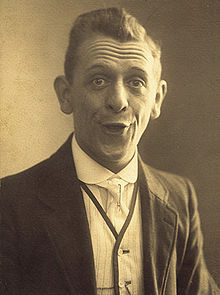Clear the ring
| Movie | |
|---|---|
| German title | Clear the ring |
| Original title | Open ring / Au revoir, M. Grock |
| Country of production | France , Germany |
| original language | French , German |
| Publishing year | 1950 |
| length | 97 minutes |
| Age rating | FSK 12 |
| Rod | |
| Director | Pierre Billon |
| script |
Nino Constantini Bluette Christin-Falaize Pierre Billon |
| production | François Carron |
| music | Henri Sauguet , Grock |
| camera | Nicolas Toporkoff |
| cut | Maurice Serein |
| occupation | |
| |
Manege frei , sometimes also with the subtitle “Grock, the man who made the world laugh”, is a Franco-German biopic from 1949 by Pierre Billon about the life of the famous Swiss clown Grock .
action
It tells the life of the Swiss Adrien Wettach, who went into the annals of circus history as the clown Grock. Wettach grew up in the small town of Biel in western Switzerland and felt drawn to the circus world from an early age. He tinkered with his own ideas, rehearsed skits and experimented with disguises until one day he was hired by a circus - albeit initially only as a cashier. Slowly but surely he works his way up with the first small appearances and makes a name for himself with his skits. As his very personal trademark, Grock established the most astonishing phrase “Nit possible!” His career went through numerous ups and downs, and an eccentric Russian countess named Barinoff became his greatest admirer and constant companion. Two world wars made him lose faith in humanity for a while, but Grock sees his task in making the tortured peoples smile again with his clowning. When Grock finishes one more performance at the end of the film, he sees his life go by again in the dark, empty arena.
Production notes
Clear the ring was in the Year 1949, the first Franco-German cooperation in the film industry after the Second World War. The film was shot in the Francoeur studio in Paris (studio recordings) as well as in the Médrano Circus and the Théatre Pigalle (also Paris). The outdoor shots were taken in Bermatingen on Lake Constance, in the vicinity of Constance and on the German-Swiss border. The premiere took place on January 19, 1950 in Paris, the German premiere took place on April 6, 1950 in Berlin.
A French and a German version of the film were produced: François Carron was the French production manager, Fred Lyssa , whose last film this was, the German one. Serge Pimenoff designed the film structures in France, Max Mellin those in southern Germany.
Reviews
In its analysis, Die Zeit wrote: “The film" Manege frei! ", Which accompanies Grock's comeback, missed the opportunity to give the only correct aspect not only of his own life but of today's world, namely that from the true perspective of the clown. Difficult to say what or who prevented it! The desire to shoot a lifelike documentary film? The fear of the main actor Grock to disappear behind his famous mask with his human individuality? This would have been his and a real feature film's great opportunity (...) The great world conflicts, which are only considered here with contemplative aperçus or faded-in pictures from political conferences, in the comic abbreviation, in the timeless tension of the foolish wise man to the current nonsense can be shown, which forms the background of this life in the ring. But as it is, a friendly, serious private individual walks slowly through his own life, comments on himself and - which is a little embarrassing - advertises himself. "
The lexicon of international films says: “This biography of Grock was recorded nine years before his death (on July 14, 1959) and tells of his life in flashbacks. The documentation of Grock's great art using the example of his classical repertoire turned out to be more convincing than the feature film-like sequences. "
Individual evidence
- ^ The time of May 4, 1950
- ↑ Clear the ring. In: Lexicon of International Films . Film service , accessed July 1, 2020 .
Web links
- Manege free in the Internet Movie Database (English)
- Clear the ring at filmportal.de
